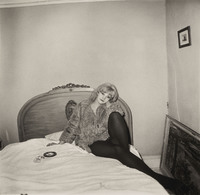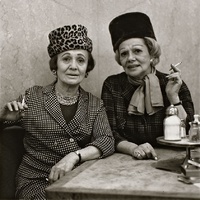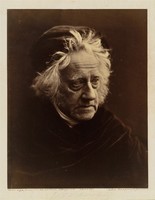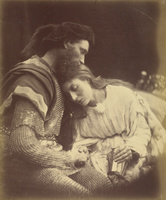Items
Tag
photograph
-
 A woman in a bird mask, N.Y.C., 1967
A woman in a bird mask, N.Y.C., 1967
-
 Two ladies walking in Central Park, N.Y.C., 1963
Two ladies walking in Central Park, N.Y.C., 1963
-
 Woman with eyeliner, NYC, 1967/2003
Woman with eyeliner, NYC, 1967/2003
-
 Seated man in a bra and stockings, N.Y.C., 1967
Seated man in a bra and stockings, N.Y.C., 1967
-
 Woman at a Counter Smoking, N.Y.C., 1962
Woman at a Counter Smoking, N.Y.C., 1962
-
 Girl in a coat lying on her bed, N.Y.C.
Girl in a coat lying on her bed, N.Y.C.
-
 Wax Museum Strangler, Coney Island, NY, 1972
Wax Museum Strangler, Coney Island, NY, 1972
-
 Woman on the Street with Her Eyes Closed Unmarked recto; stamped verso, upper left, in black ink: "Not to be reproduced in any way without written permission from Doon Arbus."; stamped and inscribed verso, upper center, in black ink: "Copyright © 19 [stamped] 86 [inscribed] / The Estate of Diane Arbus [stamped]"; stamped and inscribed verso, upper right, in black ink: "a diane arbus print [stamped] # 5B-6A-1U-1114 [inscribed] / doon arbus administrator [stamped] doon arbus [inscribed]"
Woman on the Street with Her Eyes Closed Unmarked recto; stamped verso, upper left, in black ink: "Not to be reproduced in any way without written permission from Doon Arbus."; stamped and inscribed verso, upper center, in black ink: "Copyright © 19 [stamped] 86 [inscribed] / The Estate of Diane Arbus [stamped]"; stamped and inscribed verso, upper right, in black ink: "a diane arbus print [stamped] # 5B-6A-1U-1114 [inscribed] / doon arbus administrator [stamped] doon arbus [inscribed]" -
 A Family On Their Lawn One Sunday in Westchester, New York Throughout her career, photographer Diane Arbus demonstrated a gift for capturing the unusual and eccentric in a compelling, thoughtful manner. This now-iconic photograph was originally included in a photo–essay, “Two American Families,” published in the London Sunday Times Magazine. In a letter to her editor, Arbus described encountering the woman pictured here in a bookstore: “I said I wanted to photograph her with husband and children so she suggested I wait till warm weather so I can do it around the pool! … They are a fascinating family. I think all families are creepy in a way.” Part of the caption for the image, based on Arbus’s correspondence, reads, “The parents seem to be dreaming the child and the child seems to be inventing them.
A Family On Their Lawn One Sunday in Westchester, New York Throughout her career, photographer Diane Arbus demonstrated a gift for capturing the unusual and eccentric in a compelling, thoughtful manner. This now-iconic photograph was originally included in a photo–essay, “Two American Families,” published in the London Sunday Times Magazine. In a letter to her editor, Arbus described encountering the woman pictured here in a bookstore: “I said I wanted to photograph her with husband and children so she suggested I wait till warm weather so I can do it around the pool! … They are a fascinating family. I think all families are creepy in a way.” Part of the caption for the image, based on Arbus’s correspondence, reads, “The parents seem to be dreaming the child and the child seems to be inventing them. -
 Two Ladies at the Automat (New York City) Just two years before she received her first camera, Diane Arbus wrote: “There are and have been and will be an infinite number of things on Earth. Individuals all different, all wanting different things, all knowing different things, all loving different things, all looking different… . That is what I love: the differentness.” Arbus’s appreciation for the unusual, eccentric, and extraordinary led her to photograph a range of subjects over the thirty years of her career—transvestites, giants, art philanthropists, nudists, and, as here, similarly dressed and made-up women. These ladies, with their cigarettes poised in one hand and lighters clutched in the other, occupy a booth in a New York City automat. (Now nearly obsolete and a nostalgic choice even in the 1960s, automats offered simple fare, sold from coin-operated vending machines, that was eaten at surrounding booths and counters.) Like many of Arbus’s subjects, these women were photographed in a straightforward manner. The eerily matched ladies face the camera head-on, posed in front of an unadorned marble wall and staring directly at the viewer. The candor with which Arbus presented these women is typical of the pioneering, powerful first-person directness that exists throughout her photography.
Two Ladies at the Automat (New York City) Just two years before she received her first camera, Diane Arbus wrote: “There are and have been and will be an infinite number of things on Earth. Individuals all different, all wanting different things, all knowing different things, all loving different things, all looking different… . That is what I love: the differentness.” Arbus’s appreciation for the unusual, eccentric, and extraordinary led her to photograph a range of subjects over the thirty years of her career—transvestites, giants, art philanthropists, nudists, and, as here, similarly dressed and made-up women. These ladies, with their cigarettes poised in one hand and lighters clutched in the other, occupy a booth in a New York City automat. (Now nearly obsolete and a nostalgic choice even in the 1960s, automats offered simple fare, sold from coin-operated vending machines, that was eaten at surrounding booths and counters.) Like many of Arbus’s subjects, these women were photographed in a straightforward manner. The eerily matched ladies face the camera head-on, posed in front of an unadorned marble wall and staring directly at the viewer. The candor with which Arbus presented these women is typical of the pioneering, powerful first-person directness that exists throughout her photography. -
 Gustav Klimt Photograph
Gustav Klimt Photograph
-
 Lily and Rose This image was first published in a photobook entitled Cafe Lehmitz in 1978 by Swedish photographer Anders Petersen. Various versions were subsequently printed and sold at auction. Lily and Rose graced the cover of Rain Dogs by Tom Waits.
Lily and Rose This image was first published in a photobook entitled Cafe Lehmitz in 1978 by Swedish photographer Anders Petersen. Various versions were subsequently printed and sold at auction. Lily and Rose graced the cover of Rain Dogs by Tom Waits. -
 Sir John Herschel This image depicts "Sir John Herschel, Victorian England’s preeminent scientist, astronomer, and mathematician, considered the equal of Sir Isaac Newton. Herschel wrote to her in Calcutta of Henry Talbot’s invention of photography and sent her the first photographs she had ever seen. Of her 1867 portraits of Herschel, she wrote: “From my earliest girlhood I had loved and honoured him, and it was after a friendship of 31 years’ duration that the high task of giving his portrait to the nation was allotted to me.” Of the four exposures Cameron made in April 1867, Herschel preferred this one, which portrayed him, he thought, as an 'old Paterfamilias.'"
Sir John Herschel This image depicts "Sir John Herschel, Victorian England’s preeminent scientist, astronomer, and mathematician, considered the equal of Sir Isaac Newton. Herschel wrote to her in Calcutta of Henry Talbot’s invention of photography and sent her the first photographs she had ever seen. Of her 1867 portraits of Herschel, she wrote: “From my earliest girlhood I had loved and honoured him, and it was after a friendship of 31 years’ duration that the high task of giving his portrait to the nation was allotted to me.” Of the four exposures Cameron made in April 1867, Herschel preferred this one, which portrayed him, he thought, as an 'old Paterfamilias.'" -
 Alfred, Lord Tennyson This image depicts the renowned English poet, Alfred Lord Tennyson. In addition to Cameron's multiple portraits of Tennyson, the poet commissioned a series of images to accompany his collection of twelve narrative poems called Idylls of the King.
Alfred, Lord Tennyson This image depicts the renowned English poet, Alfred Lord Tennyson. In addition to Cameron's multiple portraits of Tennyson, the poet commissioned a series of images to accompany his collection of twelve narrative poems called Idylls of the King. -
 Henry Taylor This image depicts the poet and dramatist, Henry Taylor. Taylor was a frequent sitter for Cameron over the course of her career. In addition to multiple portraits, Taylor is featured in her Idylls of the King work for poet, Lord Tennyson.
Henry Taylor This image depicts the poet and dramatist, Henry Taylor. Taylor was a frequent sitter for Cameron over the course of her career. In addition to multiple portraits, Taylor is featured in her Idylls of the King work for poet, Lord Tennyson. -
 George Frederick Watts This portrait depicts the English sculptor and painter, George Frederick Watts. Cameron and Watts met in the Little Holland House, an artist salon run by the sister of Cameron's husband.
George Frederick Watts This portrait depicts the English sculptor and painter, George Frederick Watts. Cameron and Watts met in the Little Holland House, an artist salon run by the sister of Cameron's husband. -
 Gareth and Lynette “At the Poet Laureate Alfred, Lord Tennyson's suggestion, Julia Margaret Cameron created a series of illustrations for his epic poem Idylls of the King. " This image was created to accompany the second section of the Idylls entitled "Gareth and Lynette." It depicts Lynette looking upon Gareth as he sleeps.
Gareth and Lynette “At the Poet Laureate Alfred, Lord Tennyson's suggestion, Julia Margaret Cameron created a series of illustrations for his epic poem Idylls of the King. " This image was created to accompany the second section of the Idylls entitled "Gareth and Lynette." It depicts Lynette looking upon Gareth as he sleeps. -
 Queen Guinevere “At the Poet Laureate Alfred, Lord Tennyson's suggestion, Julia Margaret Cameron created a series of illustrations for his epic poem Idylls of the King. " This image was created to accompany the 10th section of the Idylls entitled "Guinevere." It depicts the figure of Queen Guinevere, wife of King Arthur who falls in love with Sir Lancelot.
Queen Guinevere “At the Poet Laureate Alfred, Lord Tennyson's suggestion, Julia Margaret Cameron created a series of illustrations for his epic poem Idylls of the King. " This image was created to accompany the 10th section of the Idylls entitled "Guinevere." It depicts the figure of Queen Guinevere, wife of King Arthur who falls in love with Sir Lancelot. -
 The Mountain Nymph Sweet Liberty This image depicts a female model as a mountain nymph named Sweet Liberty. The image takes its name from the poet John Milton's work entitled L'Allegro, a celebration of the pleasures of life.
The Mountain Nymph Sweet Liberty This image depicts a female model as a mountain nymph named Sweet Liberty. The image takes its name from the poet John Milton's work entitled L'Allegro, a celebration of the pleasures of life. -
 The Passing of King Arthur “At the Poet Laureate Alfred, Lord Tennyson's suggestion, Julia Margaret Cameron created a series of illustrations for his epic poem Idylls of the King. " This image was created to accompany the final section of the Idylls entitled "the Passing of King Arthur." It depicts the mythic leader in medieval chainmail armor and a helmet, holding tightly to a sword.
The Passing of King Arthur “At the Poet Laureate Alfred, Lord Tennyson's suggestion, Julia Margaret Cameron created a series of illustrations for his epic poem Idylls of the King. " This image was created to accompany the final section of the Idylls entitled "the Passing of King Arthur." It depicts the mythic leader in medieval chainmail armor and a helmet, holding tightly to a sword. -
 The Parting of Sir Lancelot and Queen Guinevere “At the Poet Laureate Alfred, Lord Tennyson's suggestion, Julia Margaret Cameron created a series of illustrations for his epic poem Idylls of the King. The images that Cameron created for the Idyllsare the most illustrative works she made; she took great care with the details of costumes and props to insure the photographs' faithfulness to his narrative. She employed a variety of people as models, going to great lengths to ensure the appropriateness of sitter to subject. This image depicts the final embrace of the tragic lovers before they are forever parted.”
The Parting of Sir Lancelot and Queen Guinevere “At the Poet Laureate Alfred, Lord Tennyson's suggestion, Julia Margaret Cameron created a series of illustrations for his epic poem Idylls of the King. The images that Cameron created for the Idyllsare the most illustrative works she made; she took great care with the details of costumes and props to insure the photographs' faithfulness to his narrative. She employed a variety of people as models, going to great lengths to ensure the appropriateness of sitter to subject. This image depicts the final embrace of the tragic lovers before they are forever parted.” -
 Ellen Terry at Age Sixteen "This contemplative portrait of Ellen Terry shows as a new bride during the Shakespearean actress's honeymoon stay at Freshwater on the Isle of Wight, where Cameron lived. Terry had married the portrait painter George Frederick Watts. Terry's forlorn expression and nervous gesture may be an actress's performance put on for the camera. Employing a non-fading print process used for commercially distributed pictures, Cameron's printer made multiple carbon prints available for purchase by Terry's and Cameron's fans."
Ellen Terry at Age Sixteen "This contemplative portrait of Ellen Terry shows as a new bride during the Shakespearean actress's honeymoon stay at Freshwater on the Isle of Wight, where Cameron lived. Terry had married the portrait painter George Frederick Watts. Terry's forlorn expression and nervous gesture may be an actress's performance put on for the camera. Employing a non-fading print process used for commercially distributed pictures, Cameron's printer made multiple carbon prints available for purchase by Terry's and Cameron's fans." -
 Robert Browning This is a portrait of the English poet and playwright, Robert Browning. It was taken at the Little Holland House, according to inscription on the mount, an artists' salon run by the sister of her husband.
Robert Browning This is a portrait of the English poet and playwright, Robert Browning. It was taken at the Little Holland House, according to inscription on the mount, an artists' salon run by the sister of her husband. -
 Spiraea Aruncus Anna Atkins is one of the first documented women photographers, and is the first to create a book of photographs. She did not invent the cyanotype process, but is the one credited to its popularity. She used the chemical process to document British algae.
Spiraea Aruncus Anna Atkins is one of the first documented women photographers, and is the first to create a book of photographs. She did not invent the cyanotype process, but is the one credited to its popularity. She used the chemical process to document British algae. -
 Mount Brewer
Mount Brewer